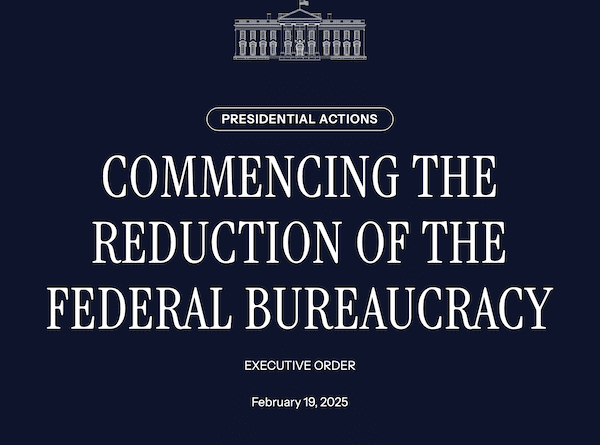The February 19, 2025 Executive Order titled “Commencing the Reduction of the Federal Bureaucracy” represents what appears to be a calculated effort to concentrate power within the executive branch under the guise of governmental efficiency. This analysis examines the order’s implications for democratic institutions and its alignment with authoritarian governance models.
The Facade of Administrative Efficiency
The executive order’s stated purpose of “dramatically reducing the size of the Federal Government” while “increasing its accountability” presents an inherent contradiction. The targeted elimination of oversight bodies and advisory committees suggests that accountability may be the first casualty of this streamlining effort.
Key Eliminations That Raise Concerns:
- The Presidential Management Fellows Program – A critical pipeline for developing non-partisan civil service leadership
- Multiple advisory committees focused on financial oversight and health equity
- Federal Executive Boards that coordinate regional government activities
- Independent foundations focused on international development and peace
Parallels to Authoritarian Playbooks
The systematic dismantling of bureaucratic structures mirrors strategies employed by authoritarian regimes to consolidate power. The order’s approach shows concerning similarities to Viktor Orbán’s transformation of Hungary’s governmental structure, where administrative “efficiency” served as a pretext for power consolidation.
Warning Signs:
- Rapid Implementation Timeline (14-30 days for major institutional changes)
- Targeting of Oversight Bodies and Advisory Committees
- Elimination of Programs Supporting Democratic Institution Building
- Concentration of Decision-Making Power in Executive Branch
The Erosion of Checks and Balances
The order’s impact on democratic safeguards is particularly troubling in several areas:
Financial Oversight
The termination of multiple financial advisory councils, including the Community Bank Advisory Council and Academic Research Council, weakens the regulatory framework protecting consumer interests and financial stability.
Health Equity
Eliminating the Health Equity Advisory Committee and Secretary’s Advisory Committee on Long COVID suggests a concerning shift away from evidence-based policymaking in crucial public health matters.
International Development
The targeting of organizations like the Inter-American Foundation and U.S. African Development Foundation signals a retreat from international engagement and democratic capacity building.
Strategic Pattern of Democratic Deconstruction
The executive order follows a calculated pattern:
- Initial Focus on “Unnecessary” Entities: Using seemingly benign efficiency arguments to justify elimination of oversight
- Rapid Implementation: Preventing meaningful resistance or debate
- Broad Executive Authority: Claiming extensive powers to reshape federal institutions
- Future Expansion Clause: Section 2(g) enables further eliminations without additional scrutiny
Implications for Democratic Governance
The order’s implementation threatens core democratic principles:
Institutional Memory
The elimination of career development programs like the Presidential Management Fellows threatens the continuity of non-partisan expertise in government.
Public Accountability
Removing advisory committees reduces transparency and limits public input in policy decisions.
Regulatory Oversight
Weakening financial and health oversight bodies could leave citizens vulnerable to corporate exploitation and health inequities.
The Broader Context
This executive order appears to be part of a larger strategy to reshape American governance. The similarities to authoritarian models suggest a concerted effort to weaken democratic institutions while maintaining a veneer of legitimate administrative reform.
Conclusion
The February 2025 executive order represents more than mere administrative streamlining—it signals a systematic effort to dismantle democratic safeguards under the pretext of efficiency. The parallels to authoritarian governance models and the targeting of oversight mechanisms suggest a calculated strategy to concentrate power within the executive branch.
The speed and scope of these changes, combined with the potential for future expansions, present a clear threat to democratic institutions. Vigilance and resistance from civil society, media, and remaining oversight bodies will be crucial in preventing further erosion of democratic safeguards.
This analysis is based on detailed examination of primary documents, including the executive order text and supporting materials, with consideration of historical precedents and authoritarian governance patterns.


